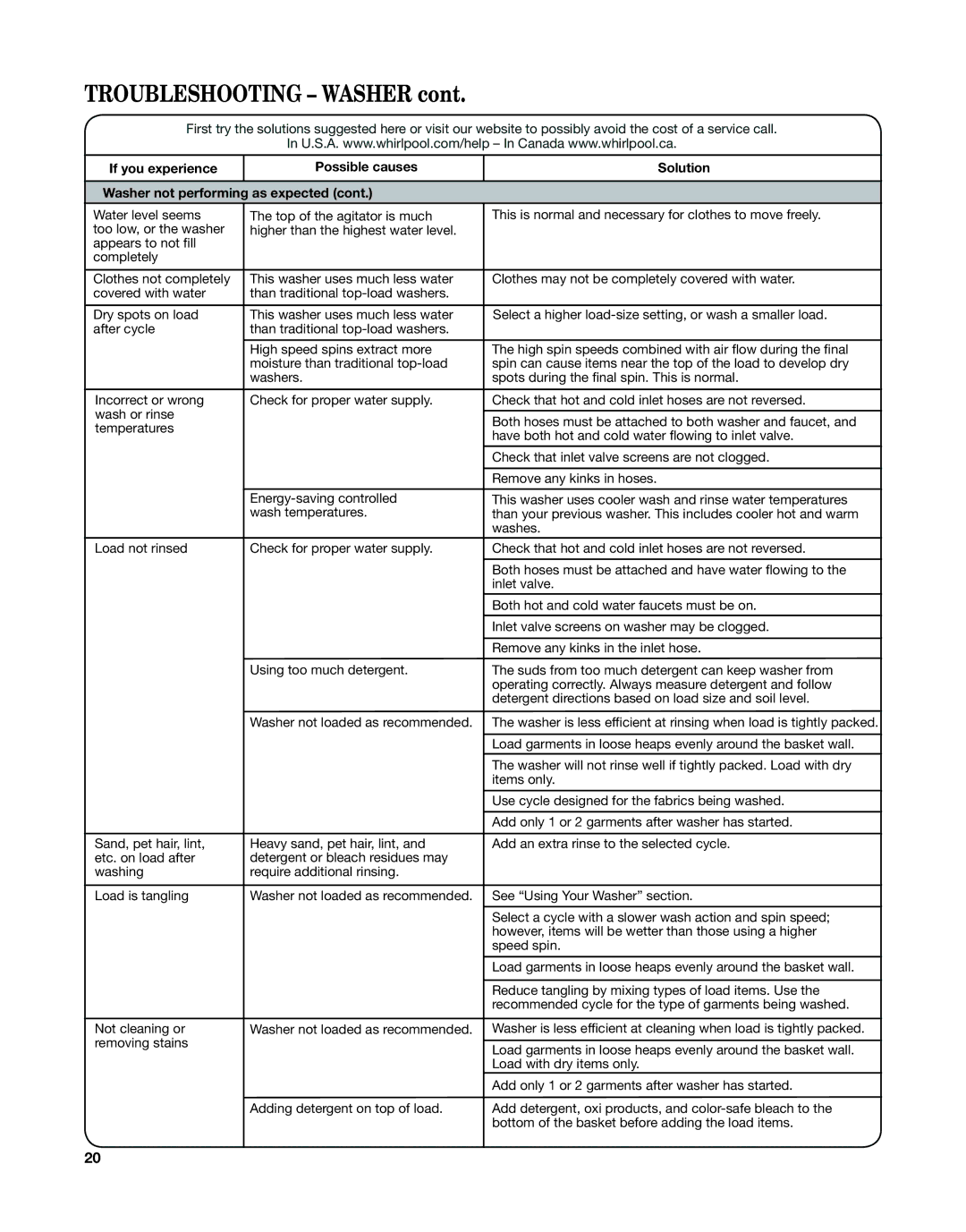
TROUBLESHOOTING – WASHER cont.
First try the solutions suggested here or visit our website to possibly avoid the cost of a service call.
In U.S.A. www.whirlpool.com/help – In Canada www.whirlpool.ca.
If you experience
Possible causes
Solution
Washer not performing as expected (cont.)
Water level seems | The top of the agitator is much | This is normal and necessary for clothes to move freely. |
too low, or the washer | higher than the highest water level. |
|
appears to not fill |
|
|
completely |
|
|
|
|
|
Clothes not completely | This washer uses much less water | Clothes may not be completely covered with water. |
covered with water | than traditional |
|
|
|
|
Dry spots on load | This washer uses much less water | Select a higher |
after cycle | than traditional |
|
|
|
|
| High speed spins extract more | The high spin speeds combined with air flow during the final |
| moisture than traditional | spin can cause items near the top of the load to develop dry |
| washers. | spots during the final spin. This is normal. |
|
|
|
Incorrect or wrong | Check for proper water supply. | Check that hot and cold inlet hoses are not reversed. |
wash or rinse |
|
|
| Both hoses must be attached to both washer and faucet, and | |
temperatures |
| |
| have both hot and cold water flowing to inlet valve. | |
|
| |
|
|
|
|
| Check that inlet valve screens are not clogged. |
|
|
|
|
| Remove any kinks in hoses. |
|
|
|
| This washer uses cooler wash and rinse water temperatures | |
| wash temperatures. | than your previous washer. This includes cooler hot and warm |
|
| washes. |
Load not rinsed | Check for proper water supply. | Check that hot and cold inlet hoses are not reversed. |
|
|
|
|
| Both hoses must be attached and have water flowing to the |
|
| inlet valve. |
|
| Both hot and cold water faucets must be on. |
|
|
|
|
| Inlet valve screens on washer may be clogged. |
|
|
|
|
| Remove any kinks in the inlet hose. |
| Using too much detergent. | The suds from too much detergent can keep washer from |
|
| operating correctly. Always measure detergent and follow |
|
| detergent directions based on load size and soil level. |
| Washer not loaded as recommended. | The washer is less efficient at rinsing when load is tightly packed. |
|
|
|
|
| Load garments in loose heaps evenly around the basket wall. |
|
|
|
|
| The washer will not rinse well if tightly packed. Load with dry |
|
| items only. |
|
|
|
|
| Use cycle designed for the fabrics being washed. |
|
|
|
|
| Add only 1 or 2 garments after washer has started. |
|
|
|
Sand, pet hair, lint, | Heavy sand, pet hair, lint, and | Add an extra rinse to the selected cycle. |
etc. on load after | detergent or bleach residues may |
|
washing | require additional rinsing. |
|
|
|
|
Load is tangling | Washer not loaded as recommended. | See “Using Your Washer” section. |
|
|
|
|
| Select a cycle with a slower wash action and spin speed; |
|
| however, items will be wetter than those using a higher |
|
| speed spin. |
|
|
|
|
| Load garments in loose heaps evenly around the basket wall. |
|
|
|
|
| Reduce tangling by mixing types of load items. Use the |
|
| recommended cycle for the type of garments being washed. |
|
|
|
Not cleaning or | Washer not loaded as recommended. | Washer is less efficient at cleaning when load is tightly packed. |
removing stains |
|
|
| Load garments in loose heaps evenly around the basket wall. | |
|
| |
|
| Load with dry items only. |
|
| Add only 1 or 2 garments after washer has started. |
| Adding detergent on top of load. | Add detergent, oxi products, and |
|
| bottom of the basket before adding the load items. |
|
|
|
20
